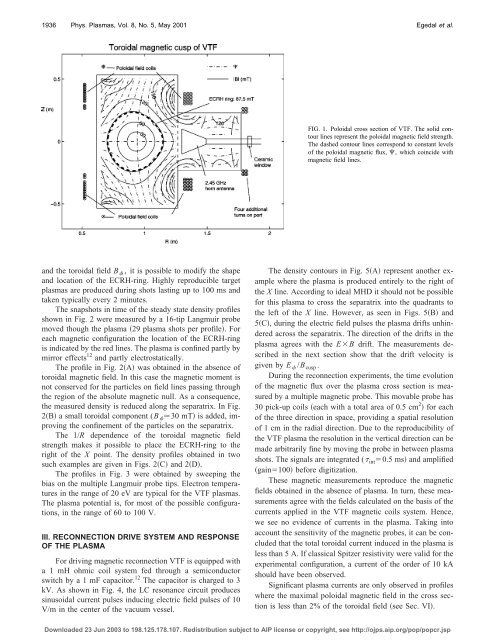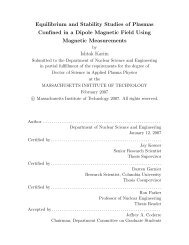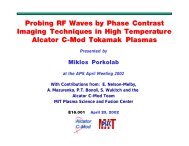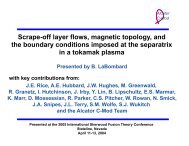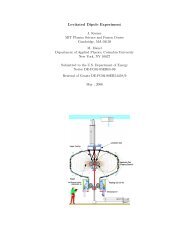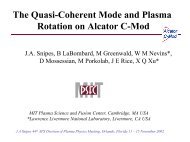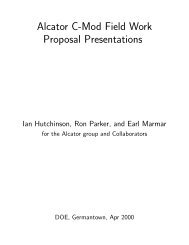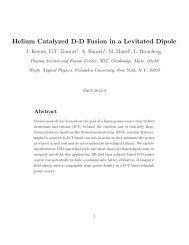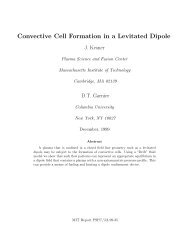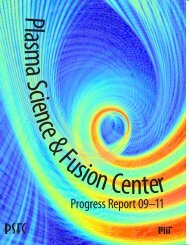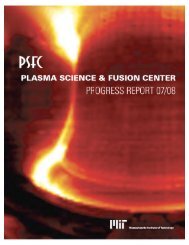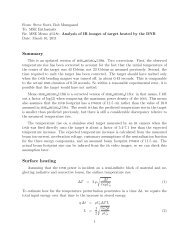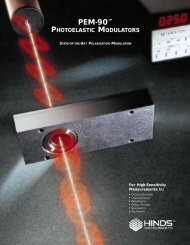pdf file - Plasma Science and Fusion Center - MIT
pdf file - Plasma Science and Fusion Center - MIT
pdf file - Plasma Science and Fusion Center - MIT
Create successful ePaper yourself
Turn your PDF publications into a flip-book with our unique Google optimized e-Paper software.
1936 Phys. <strong>Plasma</strong>s, Vol. 8, No. 5, May 2001 Egedal et al.<br />
FIG. 1. Poloidal cross section of VTF. The solid contour<br />
lines represent the poloidal magnetic field strength.<br />
The dashed contour lines correspond to constant levels<br />
of the poloidal magnetic flux, , which coincide with<br />
magnetic field lines.<br />
<strong>and</strong> the toroidal field B , it is possible to modify the shape<br />
<strong>and</strong> location of the ECRH-ring. Highly reproducible target<br />
plasmas are produced during shots lasting up to 100 ms <strong>and</strong><br />
taken typically every 2 minutes.<br />
The snapshots in time of the steady state density pro<strong>file</strong>s<br />
shown in Fig. 2 were measured by a 16-tip Langmuir probe<br />
moved though the plasma 29 plasma shots per pro<strong>file</strong>. For<br />
each magnetic configuration the location of the ECRH-ring<br />
is indicated by the red lines. The plasma is confined partly by<br />
mirror effects 12 <strong>and</strong> partly electrostatically.<br />
The pro<strong>file</strong> in Fig. 2A was obtained in the absence of<br />
toroidal magnetic field. In this case the magnetic moment is<br />
not conserved for the particles on field lines passing through<br />
the region of the absolute magnetic null. As a consequence,<br />
the measured density is reduced along the separatrix. In Fig.<br />
2B a small toroidal component (B 30 mT is added, improving<br />
the confinement of the particles on the separatrix.<br />
The 1/R dependence of the toroidal magnetic field<br />
strength makes it possible to place the ECRH-ring to the<br />
right of the X point. The density pro<strong>file</strong>s obtained in two<br />
such examples are given in Figs. 2C <strong>and</strong> 2D.<br />
The pro<strong>file</strong>s in Fig. 3 were obtained by sweeping the<br />
bias on the multiple Langmuir probe tips. Electron temperatures<br />
in the range of 20 eV are typical for the VTF plasmas.<br />
The plasma potential is, for most of the possible configurations,<br />
in the range of 60 to 100 V.<br />
III. RECONNECTION DRIVE SYSTEM AND RESPONSE<br />
OF THE PLASMA<br />
For driving magnetic reconnection VTF is equipped with<br />
a 1 mH ohmic coil system fed through a semiconductor<br />
switch by a1mFcapacitor. 12 The capacitor is charged to 3<br />
kV. As shown in Fig. 4, the LC resonance circuit produces<br />
sinusoidal current pulses inducing electric field pulses of 10<br />
V/m in the center of the vacuum vessel.<br />
The density contours in Fig. 5A represent another example<br />
where the plasma is produced entirely to the right of<br />
the X line. According to ideal MHD it should not be possible<br />
for this plasma to cross the separatrix into the quadrants to<br />
the left of the X line. However, as seen in Figs. 5B <strong>and</strong><br />
5C, during the electric field pulses the plasma drifts unhindered<br />
across the separatrix. The direction of the drifts in the<br />
plasma agrees with the EB drift. The measurements described<br />
in the next section show that the drift velocity is<br />
given by E /B cusp .<br />
During the reconnection experiments, the time evolution<br />
of the magnetic flux over the plasma cross section is measured<br />
by a multiple magnetic probe. This movable probe has<br />
30 pick-up coils each with a total area of 0.5 cm 2 for each<br />
of the three direction in space, providing a spatial resolution<br />
of 1 cm in the radial direction. Due to the reproducibility of<br />
the VTF plasma the resolution in the vertical direction can be<br />
made arbitrarily fine by moving the probe in between plasma<br />
shots. The signals are integrated ( int 0.5 ms <strong>and</strong> amplified<br />
gain100 before digitization.<br />
These magnetic measurements reproduce the magnetic<br />
fields obtained in the absence of plasma. In turn, these measurements<br />
agree with the fields calculated on the basis of the<br />
currents applied in the VTF magnetic coils system. Hence,<br />
we see no evidence of currents in the plasma. Taking into<br />
account the sensitivity of the magnetic probes, it can be concluded<br />
that the total toroidal current induced in the plasma is<br />
less than 5 A. If classical Spitzer resistivity were valid for the<br />
experimental configuration, a current of the order of 10 kA<br />
should have been observed.<br />
Significant plasma currents are only observed in pro<strong>file</strong>s<br />
where the maximal poloidal magnetic field in the cross section<br />
is less than 2% of the toroidal field see Sec. VI.<br />
Downloaded 23 Jun 2003 to 198.125.178.107. Redistribution subject to AIP license or copyright, see http://ojps.aip.org/pop/popcr.jsp


